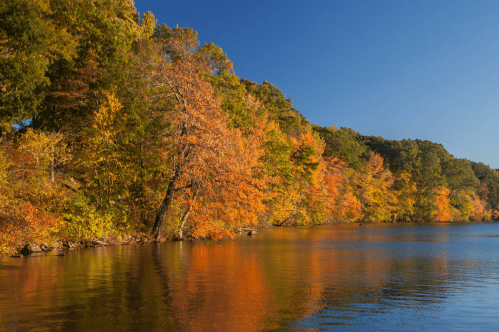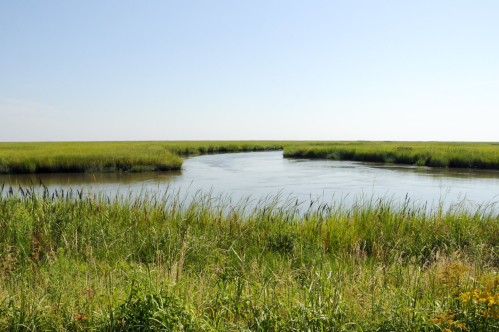New York's summertime heat may compel us to go searching for the nearest body of water to cool off in, but this year there are some lakes and beaches that you'll want to avoid. A cause for concern that sadly isn't new to New Yorkers, according to the latest information posted by the DEC - there are quite a few lakes that have been confirmed for having toxins and harmful compounds that are referred to as HABs. Interested in arming yourself with this useful information? Then let's keep scrolling to take a look at exactly what we're dealing with.
New York has always been known for having clean, pristine, stunning lakes throughout our state, yet unfortunately, right now there are quite a few of them that are completely unsightly.
When we think about our lakes in New York, gorgeous destinations like Skaneateles Lake, Green Lakes State Park, and Lake George are just a few that come to mind. Unfortunately, there happen to be numerous lakes within our state right now that are so overrun with Harmful Algal Blooms that you wouldn't even consider touching them with a 10-foot pole. Eek!
According to the latest information that stays updated on the HAB's Notification Page, there are a total of 40 lakes in our state that have confirmed cyanobacteria in their bodies of water.
On that HAB Notification Page, you'll see a chart detailing bodies of water containing HAB notifications - varying from Suspicious, Confirmed, and Confirmed with High Toxins Bloom statuses. For the 6 lakes listed as having a status of "Confirmed with High Toxins Bloom", this means that water sampling results have confirmed that there are toxins present in enough quantities of the water that could potentially cause health effects when people or animals come in contact with it through either drinking or swimming. While the 34 lakes listed as having a status of "Confirmed Bloom" have had water sampling results that confirmed the presence of cyanobacteria HAB which may produce toxins and other harmful compounds.
For the remaining 17 lakes that are listed with the "Suspicious Bloom" status, this means that the DEC staff has determined the conditions fall within the description for HAB, but it is still unknown if toxins or other harmful compounds are in the water. This also means that these lakes could contain cyanobacteria that could still be an irritant to some people, even if toxins aren’t present in the water.
Now let's discuss which 6 lakes currently have a "Confirmed with High Toxins Bloom" status, and what you should do if you happen to come in contact with them.
So, what does the DEC want you to know about HABs? If you see anything, be sure to avoid it and report it. If you see any bodies of water with discoloration or algae scums on the surface - avoid the water at all costs. Coming in contact with the water can cause symptoms such as nausea, vomiting, diarrhea, irritation of the skin, eyes, and throat, allergic reactions, and possibly even difficulty with breathing if you’ve drunk the water.
If You Only Have One Day to Visit This Small Town in Rhode Island, Here’s Everything You Absolutely Can’t Miss

If You Only Have One Day to Visit This Small Town in Maine, Here’s Everything You Absolutely Can’t Miss

If You Only Have One Day to Visit This Small Town in Massachusetts, Here’s Everything You Absolutely Can’t Miss

With that said, here are the 6 lakes that you need to currently avoid:
Central Park Lake (New York County) - Widespread / Lakewide as of 8/6/18
Java Lake (Wyoming County) - Large Localized as of 8/7/18
Lake Ronkonkoma (Suffolk County) - Large Localized as of 7/31/18
Prospect Park Lake (Kings County) - Widespread / Lakewide as of 8/6/18
Sucker Brook (Cayuga County) - Small Localized as of 8/6/18
Skaneateles Lake (Onondaga County) - Small Localized as of 8/4/18
*Note: Skaneateles Lake is currently on this list due to the fact that Lourdes Camp was recently shut down. The listing refers to the specific area contained on the shoreline of the camp’s 1,500-foot lakefront, where blue-green algae blooms have been found, making the camp’s water supply unsafe to drink and swim in.
Lakes with their bloom extent listed as being Widespread / Lakewide have blooms that are affecting their entire bodies of water, a large portion of the lake, or most to all of the shoreline. Small Localized statuses mean that the bloom affects only a small area of the lake, and Large Localized statuses mean that the bloom is currently affecting large areas of the shoreline, a specific region of the water, or many properties within an entire cove.
If you believe you’ve come across a HAB in a body of water or yourself, family, friends, or pets have come in contact with a bloom - report the bloom to the DEC. People can fill out and submit a Suspicious Algal Bloom Report, and also send digital photos of suspected blooms to [email protected].
Subscribe to our newsletter
Get the latest updates and news
Thank you for subscribing!

















